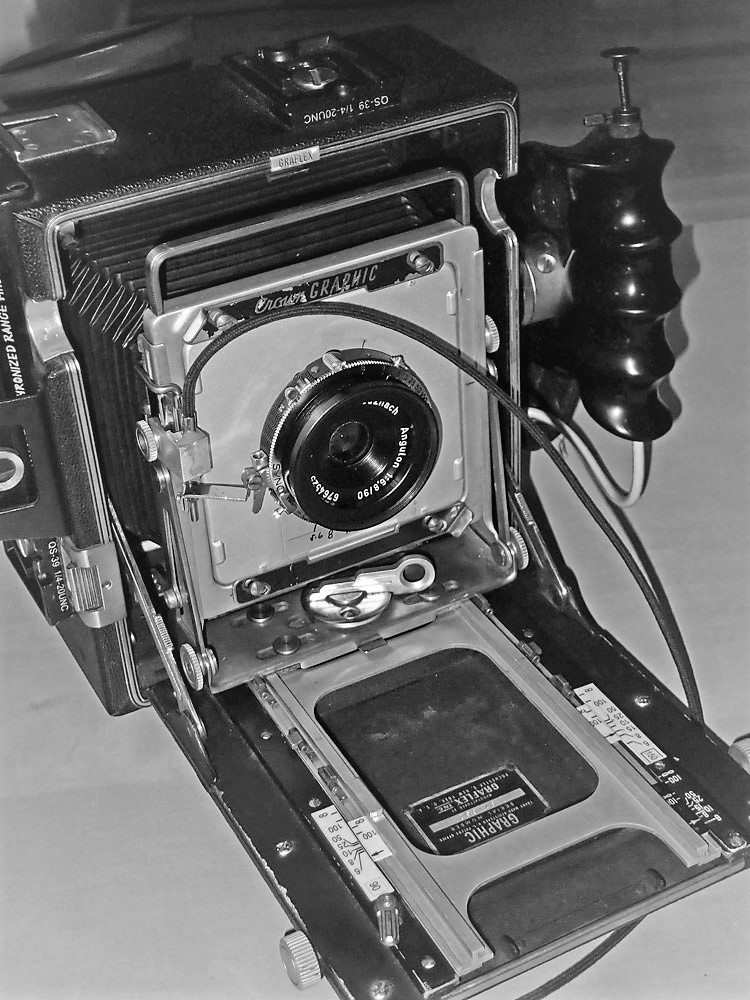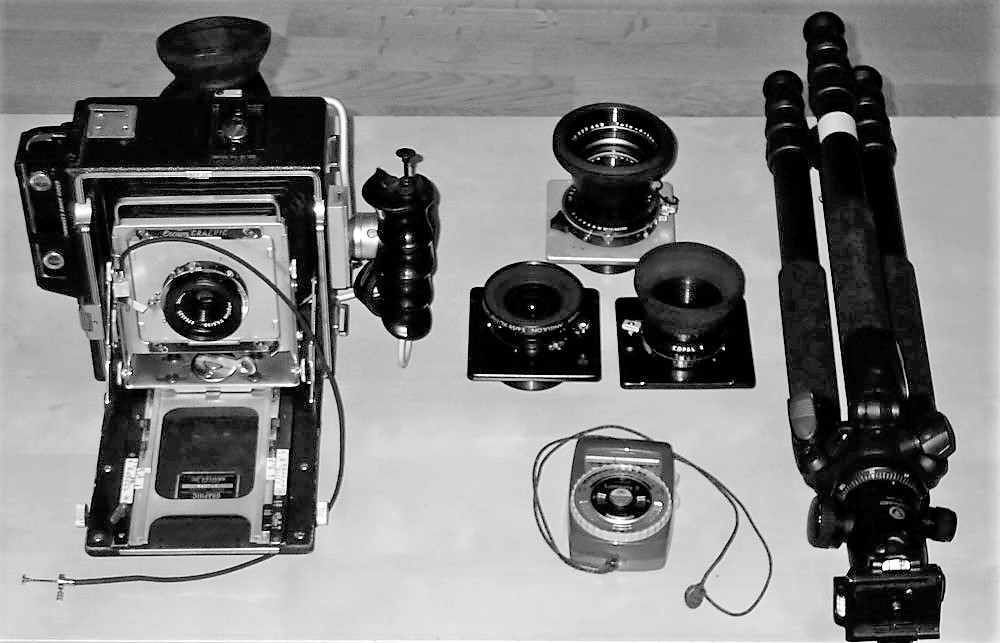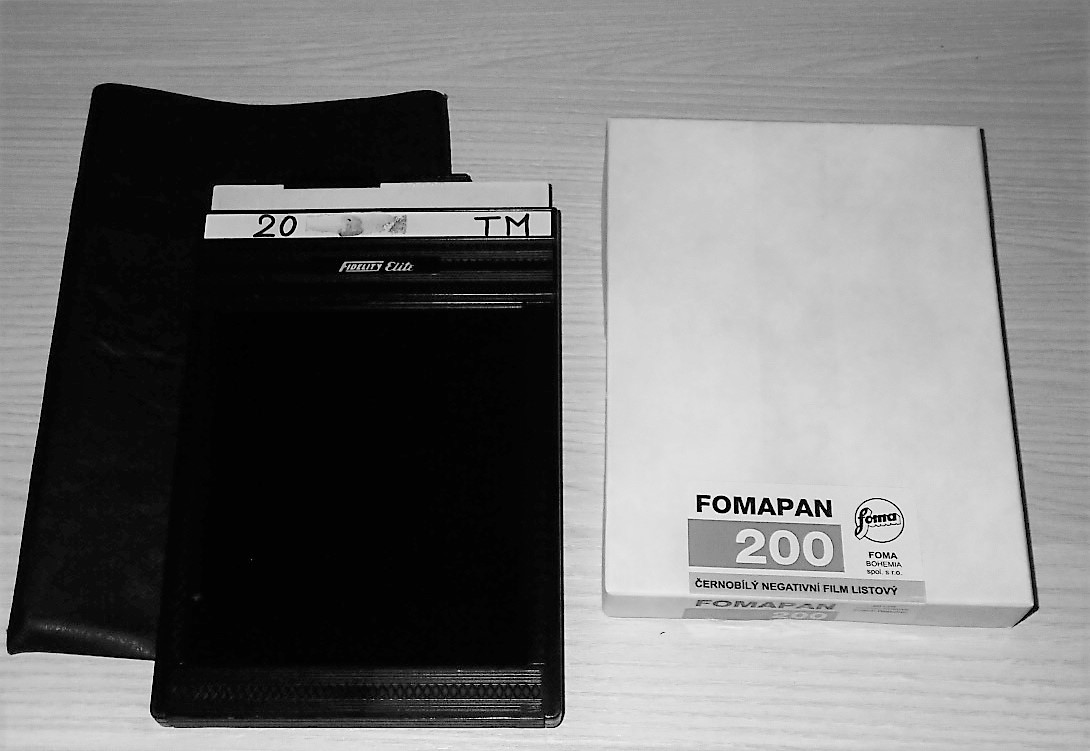
 Camera: The key part of my photographic equipment is the famous US press camera Graflex Pacemaker Speed Graphic, widely used by US journalists till mid 60s. My camera with the serial number 871362 was manufactured beginning 50s. This camera was modified by myself: A new ground-glass lift mechanism reduced the force needed to insert the film holder. An angular swivel viewfinder replaced the original viewing hood, now enabling a magnified look at the ground glass from any direction. Adapters mounted on 3 camera housing sides make 3 ways possible, how to attach the camera on a tripod. A new Linhof-style side handle with integrated cable release makes the camera setup and manipulation much easier. In (rare) cases, when a tripod is not used, the original optical viewfinder is replaced by a Linhof one with a variable focal length. This modified Graflex camera replaced a cardan-type camera, inspired by Sinar F1, developed by myself in 90s and used till 2010.
Camera: The key part of my photographic equipment is the famous US press camera Graflex Pacemaker Speed Graphic, widely used by US journalists till mid 60s. My camera with the serial number 871362 was manufactured beginning 50s. This camera was modified by myself: A new ground-glass lift mechanism reduced the force needed to insert the film holder. An angular swivel viewfinder replaced the original viewing hood, now enabling a magnified look at the ground glass from any direction. Adapters mounted on 3 camera housing sides make 3 ways possible, how to attach the camera on a tripod. A new Linhof-style side handle with integrated cable release makes the camera setup and manipulation much easier. In (rare) cases, when a tripod is not used, the original optical viewfinder is replaced by a Linhof one with a variable focal length. This modified Graflex camera replaced a cardan-type camera, inspired by Sinar F1, developed by myself in 90s and used till 2010.
 Equipment: I use Schneider Super Angulon 5,5/58, Schneider Super Angulon 6,8/90, Rodenstock Sironar 5,6/150 and Schneider Tele-Arton 5,5/270 lenses, exposure meter Gossen Lunasix 3, tripod Vanguard SBH-100 with ball head and (of course) a set of filters. The extremely wide angle lens 58 mm can be (thanks to it´s design) used on Graflex without any adapter.
Equipment: I use Schneider Super Angulon 5,5/58, Schneider Super Angulon 6,8/90, Rodenstock Sironar 5,6/150 and Schneider Tele-Arton 5,5/270 lenses, exposure meter Gossen Lunasix 3, tripod Vanguard SBH-100 with ball head and (of course) a set of filters. The extremely wide angle lens 58 mm can be (thanks to it´s design) used on Graflex without any adapter.
 Transport: The whole equipment is relatively compact and lightweight (considered large format weight relations). The packed camera with 3 lenses and tripod does not go far over 20 lb. As the result, this equipment is quite mobile, not restricting a destination area selection. Btw. this mobility together with wide-angle capability was the main motivation, why to replace the old cardan camera.
Transport: The whole equipment is relatively compact and lightweight (considered large format weight relations). The packed camera with 3 lenses and tripod does not go far over 20 lb. As the result, this equipment is quite mobile, not restricting a destination area selection. Btw. this mobility together with wide-angle capability was the main motivation, why to replace the old cardan camera.
 Film, chemistry: Following years of experiments I ended up with a Czech F200 4x5" flat film (made by FOMA Bohemia), "cooperating" very well with the specific "Stand development" method: Films are developed in a horizontal position (in special holders), with no agitation, in diluted Rodinal, 1:100 at 68-72°F, 60 min. This development method makes "miracles" in term of increased edge sharpness and light areas compensation effect. The results are much better compared with classical JOBO processor development.
Film, chemistry: Following years of experiments I ended up with a Czech F200 4x5" flat film (made by FOMA Bohemia), "cooperating" very well with the specific "Stand development" method: Films are developed in a horizontal position (in special holders), with no agitation, in diluted Rodinal, 1:100 at 68-72°F, 60 min. This development method makes "miracles" in term of increased edge sharpness and light areas compensation effect. The results are much better compared with classical JOBO processor development.
Enlarging: I use an old 13x18 Meopta Magnitarus enlarger, adapted for color filters. 20x23" Foma Variant papers with variable gradation are developed in a standard positive developer Foma LQN and dried on a glass plate.
Scanning of negatives: A flatbed scanner Epson V700 is used, the final file processing is usually made in Photoshop. The scanned representation does not apply for final prints.
